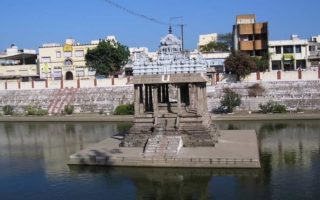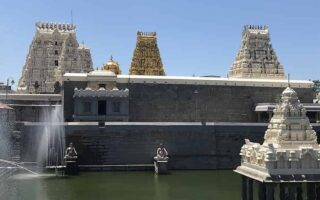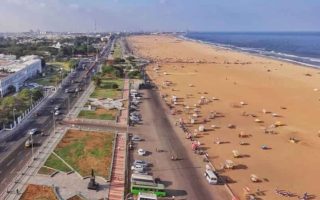Tamil Nadu is often referred as the ‘The Land of Temples’ for its matchless mastery in temple architecture. These temples are the evidence of the glorious heritage of the Tamil Nadu region. Tamil Nadu temples were built over a vast period of time by many dynasties. These Temples were constructed by the Pallavas, Pandyas, Vijayanagar rulers, the Nayakas and particularly the Cholas.
The Tamil Nadu temples are the best gifts that Dravidians left to the present people of Tamil Nadu. The inheritance of ancient Dravidian art and culture is still preserved here in all its grandeur. The Tamil Nadu Temples were also much more than a place of worship.
They were also a place for social gathering, for education, for celebration etc. Tamil Nadu temples tour gives you excellent chance to visually perceive these wonders.
Temples of Tamil Nadu
Tamil Nadu reflects early Dravidian art and culture, described by ornamented temples with soaring towers known as gopurams (tower over the entrance). There are more than 30,000 temples in Tamil Nadu built by many dynasties. The earliest temples were built by brick and mortar. Upto about 700 CE temples were hollow out of rocks. These temples share the similar physical features like the gopurams over the entrance gates on all the four directions, the Vimana (tower over the sanctum) and the large halls and passageway. The Mighty Cholas added many ornamental halls (mandapams) to temples and erected large gopurams. The Pandya Style is known for the appearance of huge towers, high wall attachments and giant towered gateways. The Vijayanagar Style is noted for the complexity and beauty particularly for the ornamented monolithic pillars. The Naik style is well known for the addition of large circumambulatory paths and huge pillared halls.
Kailasanatha Temple
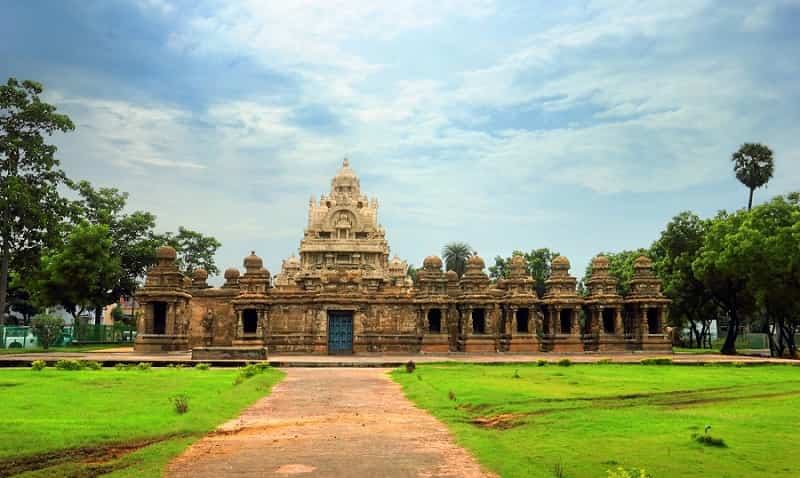
Kailasanatha Temple is dedicated to Shiva who is believed to reside in the Kailash mountains. This is the oldest temple in Kanchipuram and is also the most beautiful one. The temple structure reflects the Dravidian architecture. It was built in the 7th century by Pallava king Rajasimha, while the front part was added later by his son King Varman III. The remaining parts of 8th century murals will give you the idea about the advanced architecture of the ancient times. The original temples must have looked splendid, it seems.
There are as many as 58 small shrines in the honor of Shiva and Parvati and their sons – Ganesh and Murugan. Non-Hindus are not allowed to enter the sanctum where a spectacular lingam is placed, which is also the third largest in India. You can hire a guide here that will not cost much but will help you to explore the place better. This temple remain open all days of week
- Address: Pillaiyarpalayam, Kanchipuram, Tamil Nadu 631501
- Timings: 6am to 12.00pm and 4pm to 7.00pm
- Visit Duration: 1 to 2 hours
- Entry Fee: No entry fee
Ramanathaswamy Temple
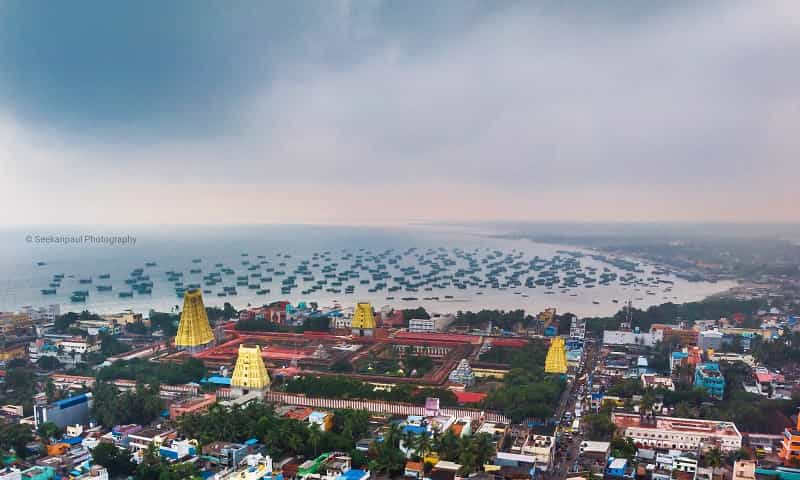
The Ramanathaswamy Temple is a beautiful example of Dravidian architecture. The temple remains open from 4 am in the morning till 8:30 pm with a two hours closing from 1pm to 3pm. The structure of the temple is quite famous for its four brilliant corridors. There are sculpted pillars aligned to these corridors. The temple was constructed in phases and the actual construction work began as early as in 12th century. Many additions were made to the structure, the most important among them is a 53 meters high gopuram. There are 22 Teerthams within the temple where the pilgrims take bath and purify themselves. The water in these Teerthams is considered as holy and pilgrims also drink from them. The inner sanctum is only allowed for Hindus where you can find the paintings which will depict the original Rameswaram as per Hindu mythology.
- Address: Rameswaram, Tamil Nadu 623526
- Timings: 5:00 AM – 9:00 PM
- Entry fee: No entry fee, 25 for Still Camera
- Visit Duration: 1 to 2 hours
[Also Read: List of Popular Museums to Visit in Tamil Nadu]
Kolavizhi Amman Temple
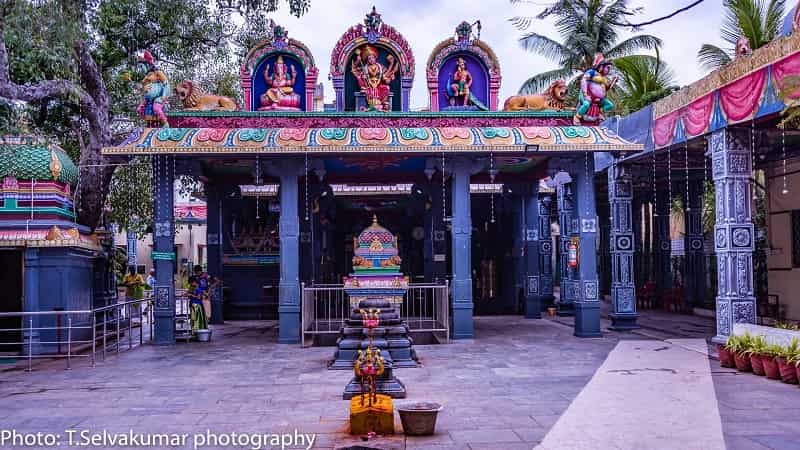
According to legend, a visit to the Kolavizhi Amman Temple is enough to rid a person of all his ailments and diseases. Dedicated to the Goddess Pattu Kolavizhi Amman (a form of the Divine Mother) the temple is located in Chennai.
- Address: Karaneeswarar Koil 2nd Lane, Basha Garden, 600004 Chennai
- Entry Fee: No entry fee
- Timings: 5:00 AM – 9:00 PM
- Visit Duration: 30 minutes
Kumari Amman Temple
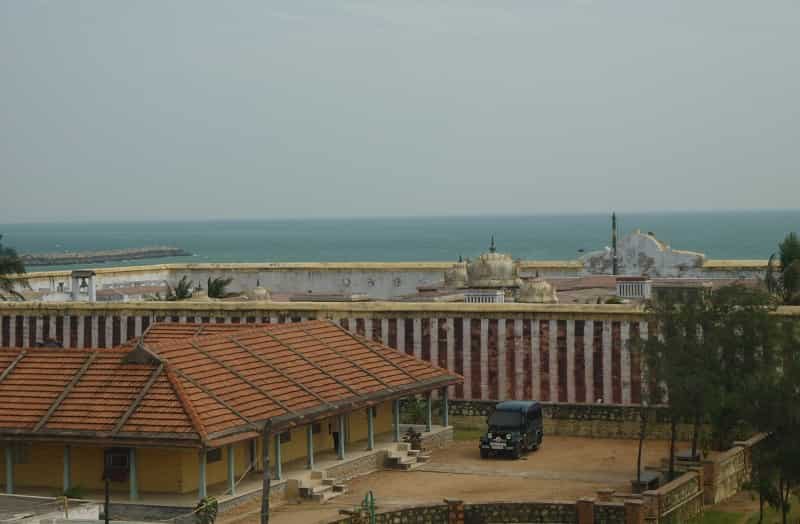
This is a temple devoted to Kanya Goddess Devi and located in Kanyakumari, who single handedly conquered the demons and secured freedom for the people. The temple is a nice place to do the prayer. It opens early morning around 4:30 am. While entering into the temple men have to remove their shirts. Cameras and videos are not allowed inside the temple. If you enjoy Cars Festival, where an idol of deity is taken for the procession, then you should go here in the month of May or June.
- Address:Temple Road, Kanyakumari, Tamil Nadu 629702
- Timings:30 Am – 12.30 PM & 4:00 – 8:00 PM
- Visit Duration: Approx 1-2 hrs
- Entry Fee: No entry fee
[Must Read: Awesome Hill Stations Visit in Tamil Nadu]
Samayapuram Mariamman Temple
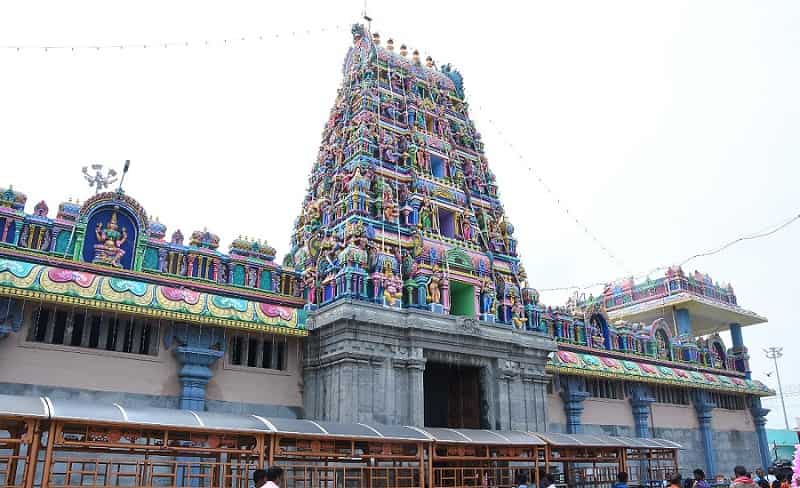
Presided by Goddess Mariamman –the popular Hindu Goddess of Rain in the southern parts of India, Samayapuram Mariamman temple lures devotees to the small village of Samayapuram, Tiruchirappalli. Best visited during the period of Chithirai Chariot Festival, which is celebrated with a lot of fanfare and fervor for 13 days in April; this venue of great religious significance is thronged all across the year.
During this very popular festival, you can feast your eyes upon the deity pulled by devotees in an amazingly beautiful Chariot Car. Visited by lakhs of devotees during the festival, this temple is best visited for the Samayapurathu Mariamman —which is clearly visible from the main entrance. A must visit for one and all!
- Address: Samayapuram 621112 Tiruchchirappalli
- Timings: 5:30 AM – 9:30 PM
- Visit Duration: 30 to 45 minutes
- Entry Fee: No entry fee
Thillai Kali Amman Temple
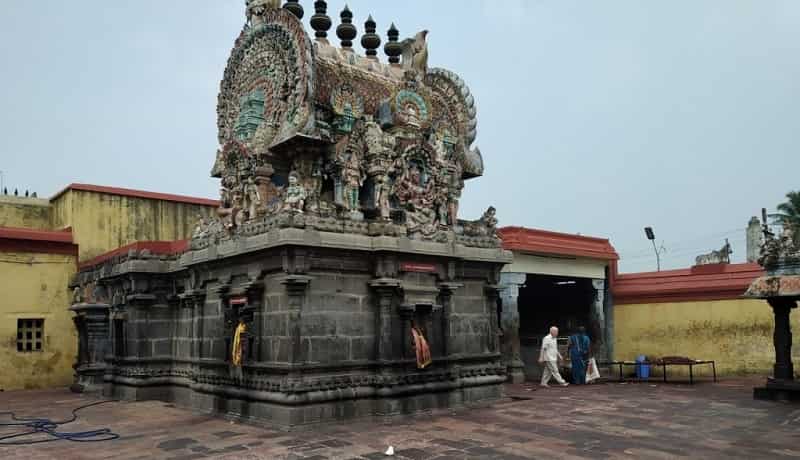
Probably constructed under the aegis of King Kopperunchinga who ruled from 1229 to 1278, the Thillai Kali Amman Temple is a known Shakti Sthala. Located on the northern part of the Chidambaram temple, the Thillai Kali Amman Temple is very popular and devotees come here to seek blessings and ask for health and prosperity. According to legends, Shiva and Shakti decided to compete to decide who is a better dancer. During the course of the dance in which they were copying each other’s movements, Shiva struck a pose with his leg raised high in the air.
Shakti being a woman could not follow as this would have compromised her modesty and hence lost to him. Following the rules of the dance contest, Shakti had to leave the spot and reside outside. She did so and moved to the edge of the complex, and a Kali temple was established there and dedicated to her.
- Address: Thillai Vanan, Thoppu Road 627104 Cuddalore, Tamil Nadu
- Timings: 6:00 AM – 9:00 PM
- Visit Duration: 30 minutes to 1 hour
- Entry Fee: No entry fee
[Also Read: Popular Beaches of Tamil Nadu]
Jagannathan Temple
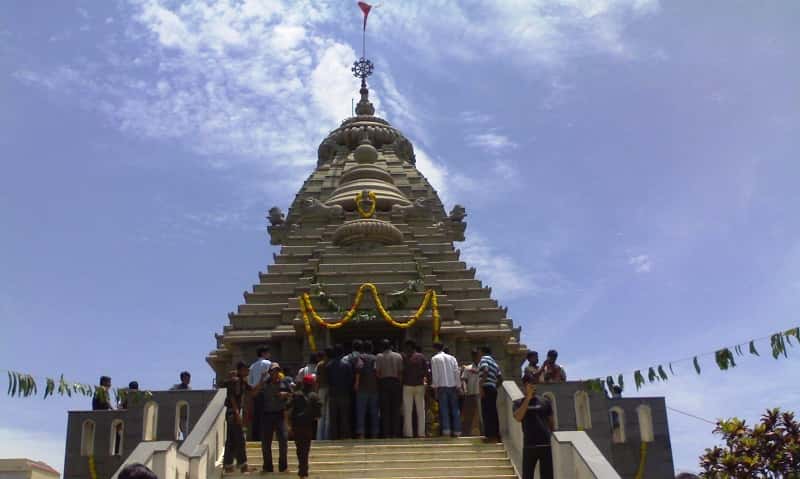
One of the more popular temples in Chennai, the Jagannathan Temple is dedicated to one of the incarnations of Lord Vishnu, that as Lord Jagannath. Following the same set up as the famous and original Lord Jagannath Temple at Puri, the idols of Balaram and Subhadra are placed on either side of Lord Jagannathan in the sanctum sanctorum of the temple. Similarly, the chariot procession is also carried out during the festival of the Rath Yatra which is held every year in June-July.
- Address: CLV Nagar Main Rd 603103 Chennai
- Timings: 6:30 AM – 7:30 PM
- Entry Fee: No entry fee
- Visit Duration: 15 to 30 minutes
Viswaroopa Adhivyadhihara Sri Bhaktha Anjaneyaswami Temple
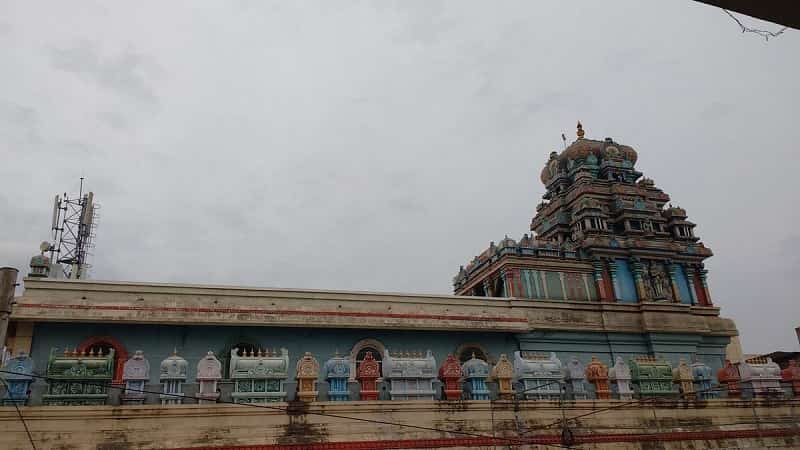
Located on the outskirts of Chennai, the Viswaroopa Adhivyadhihara Sri Bhaktha Anjaneyaswami Temple, has a huge thirty two feet high black granite statue of Lord Anjaneyaswami right up in front. The main temple is flanked by two temples dedicated to Lord Rama and Lord Krishna. Clean, peaceful and serene, the temple offers Prasadam to the devotees throughout the day as well as feeding the poor for free. A visit to this place to experience the serenity and spirituality that this temple can offer will only enrich your mind and soul.
- Address: 1, 8th Street, Ram Nagar, Nanganallur 600061 Chennai
- Visit Duration: Around half an hour
- Timings:
- Morning: 00am to 12.00pm
- Evening: 4.30pm to 9.00pm
- Entry Fee: No Entry Fee
Dhenupureeswarar Temple
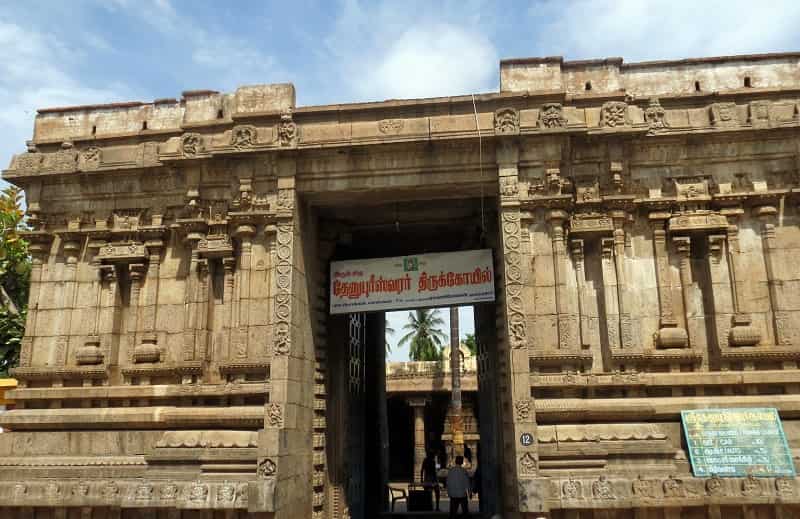
Located at Patteeswaram, the Dhenupureeswarar Temple, Tamil Nadu is associated with many legends. According to them, it is here that Goddess Parvati did penance to marry Lord Shiva while standing on one leg. This is also the place where Kamdhenu, the heavenly cow and later her daughter, Patti worshiped Lord Shiva by showering the lingam with their milk. The deity is named after Kamdhenu and the village is named after Patti. Lord Rama after killing Ravana came here to atone for his sin. Rishi Vishwamitra was given the Gayatri Mantra here and conferred the title of Brahmarishi.
A more contemporary legend states that when Thirugnanasambandar, the child saint visited the temple on a rather hot day, Lord Shiva instructed his Ganas to shelter his devotee by holding a pearl canopy over his head. Eager to see his devotee, the Lord also asked Nandi, his steed to move to the side. Nandi did so, and when you visit the temple, you will see the statues of Nandi towards the side and not in front of the sanctum, as it usually is everywhere else.
According to inscriptions, the idol of Goddess Durga was moved to this temple by a Chola King, from her shrine by the fortress gate. An amazingly beautiful temple with three Prakarams, five towers and fine and intricate sculptures and panels, the temple should be visited if only for the artistic work done here.
- Address: Madambakkam Main Rd, Madambakkam 600126 Chennai
- Timings: 5:00 AM – 12:00 PM and 4:00 PM – 9:00 PM
- Visit Duration: 1 to 2 hours
- Entry fee: No entry fee
Brahmapureeswarar Temple
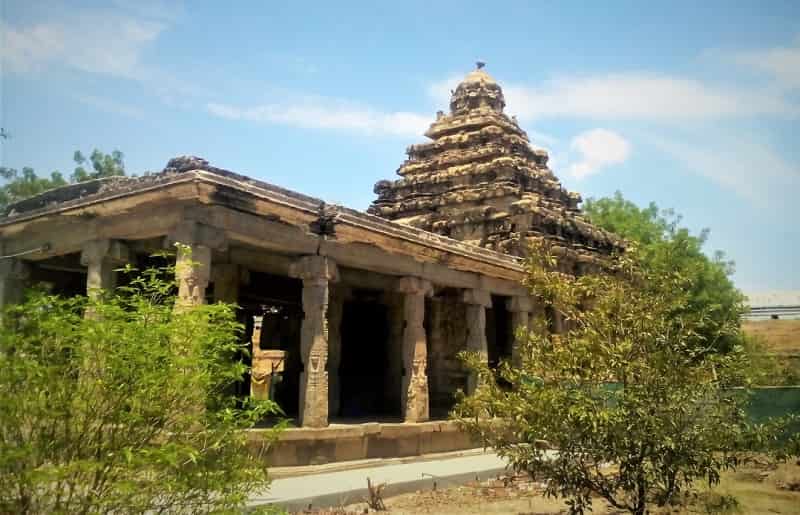
According to legend, Lord Shiva once cursed Lord Brahma and took away all his powers. Relenting later, he restored the power back with Lord Brahma as the Creator of the Universe – the Brahmapureeswarar Temple, Tamil Nadu stands on the site where this sacred event took place. The legend tells how Lord Brahma in his pride as the Creator, incurred the wrath of Lord Shiva who cursed him and rendered him powerless. To atone for his mistake, Brahma undertook a pilgrimage of all the Shiva temples. At Brahmapureeswarar Temple Lord Brahma took upon himself to set up twelve Lingams, which can still be seen today. Appeased by the penance of Brahma and heeding to an appeal by Goddess Parvati, Lord Shiva came to this spot and freed Lord Brahma of the curse. He restored the powers back to Lord Brahma and blessed him by granting him a shrine at this temple.
There are very few temples and shrines dedicated to Lord Brahma and this is one of the revered ones. Devotees believe that as this was the place where Lord Brahma’s destiny was re-written, offering prayers here will change the course of their own destiny, leading them to a better life.
- Address: Siruganur, Thirupattur 621105 Vellore
- Timings: 7:00 AM – 8:00 PM
- Visit Duration: 45 minutes to 1 hour
- Entry Fee: Free
Nataraja Temple Chidambaram
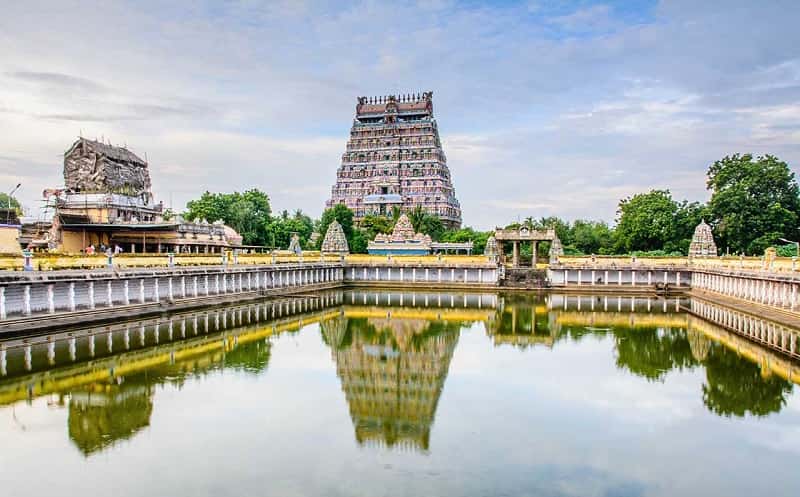
In South India most of the temples are dedicated to Lord Shiva and among all these Shiva temples, the Shiva temple of Chidambaram has earned the worldwide fame. Situated around 250 Km south of Chennai. Shiva Temple of Chidambaram is one of the most marvelous temple complex in South India. This temple is spread over an area of approx 18 hectare and is often referred to as the heart of city. The Nataraja temple complex is in rectangular shape and is divided into five courtyards, four of which can be visited by the public while the fifth one is only for priests and other visitor are not allowed here. Nataraja Temple has nine gateway towers and five halls. There are five major and several small shrines in this temple complex and a number of water tanks are also there in Nataraja temple. It is also one of the most ancient temples of Tamil Nadu. Tourists from all around the world come to visit Nataraja Temple for its religious and architectural importance.
Nataraja temple is dedicated to Lord Shiva. Nataraja, which means the cosmic dancer, is another name of Lord Shiva which is the main deity in this temple. The legend goes like, once Shiva was strolling in the forest of Thillai with Lord Vishnu as his consort with the name of Mohini. In the forest resided a group of sages who believed in the supremacy of magic. Wives of all sages got enchanted with the beauty of Shiva and his consort and sages got enraged by this. They invoked serpents and then invoked a demon. However, Shiva wore serpents as ornaments and started doing Anand Tandava on the back of the demon. Ananda Thandavam or the cosmic dance is a dance of bliss, which symbolizes five divine acts – creation, sustenance, dissolution, concealment and bestowment.
- Address: Chidambaram, Tamil Nadu 608001
- Timings: 6.30 pm to 10.30 pm
- Visit Duration: 1-2 hours
- Entry Fee: No entry fee
Thiruchendur Temple
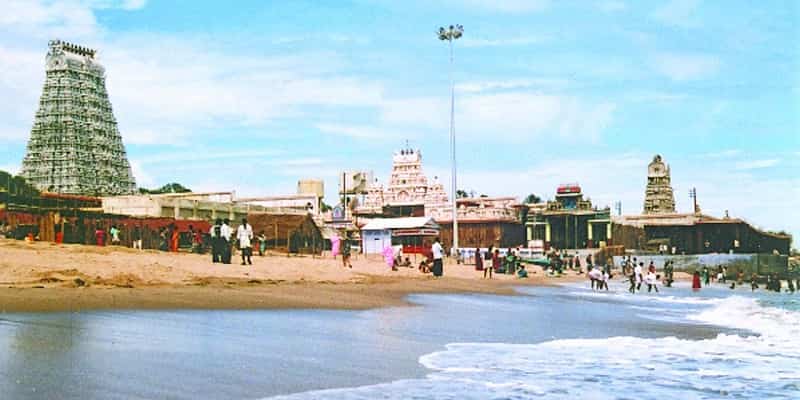
Thiruchendur Murugan Temple is the most important Hindu Temple that is committed to Lord Muruga. Along with Lord Muruga also to the Arupadaiveedu which is amongst the six main abodes belonging to the Lord Muruga. It is situated in a very small town of Thiruchendur in the Tuticorin district of Tamil Nadu in India. The temple is at a distance of 55 kilometers from the southeast of Tirunelveli, around 40 kilometers away from the Tuticorin and at a distance of 75 kilometers from Kanyakumari. The temple is very easily accessible by car or by bus. Train services are also available from Thiruchendur which is the nearest railway station. This temple is amongst the fourth temple from the Hindu Religion to get an ISO certificate. The Kumbhabhishekam of this temple was in the year of 2009. After so long time, there were the schemes implemented in this temple.
Significance of the Temple
There are in all six most important abodes of God Murugan and they are revealed in the Puranas. Thiruchendur is the second amongst the six abodes. The temple is not only known by the name of Thiruchendur but also by the various names from the literature and the religious poems as Thiruchenthil, Thirucheeralaivai and Tiruchendur. The Lord present here is known by the various names such as Senthilandavan and so many. The six major abodes or the Arupadai Veedu are Swamimalai at a distance of 150 kilometeres from the east located in Madurai, Palani at a distance of 120 kilometers from the west of Madurai, Thiruthani at a distance of 50 kilometers away from Chennai, Thiruparamkunram at a distance of 10 kilometers from Madurai and Pazhamudircholai at a distance of 10 kilometers away from South of Madurai.
- Address: Thiruchendur, Tamil Nadu 628215
- Timings: 5.00 pm to 09.00 pm
- Visit Duration: 1-2 hours
- Entry Fee: No entry fee
List of Other Temples in Tamil Nadu
Thanjavur Temples
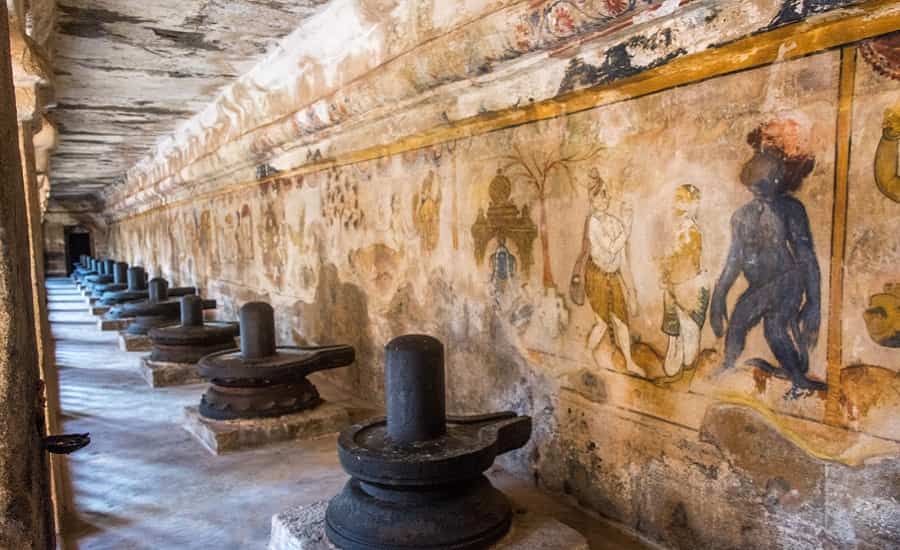
Thanjavur was the Capital city of the Cholas, Nayaks and the Mahrattas. Thanjavur was at height of its splendor during the great Rajaraja Cholan. There are a lot of beautiful temples in and around Thanjavur area. The famous Big Temple stands tall with its beaming tower. It’s really one of the architectural marvels of the world. The specialty of this temple is that it has been constructed completely with stones without having the Mountain around Thanjavur and surroundings. The height of centre tower (vimana) is 64.8m. The frescoes decorating the walls and ceilings of the inner courtyard have been dated to Chola times (1000 years ago) and were implemented using techniques similar to those used in European frescoes work.
Madurai Temples
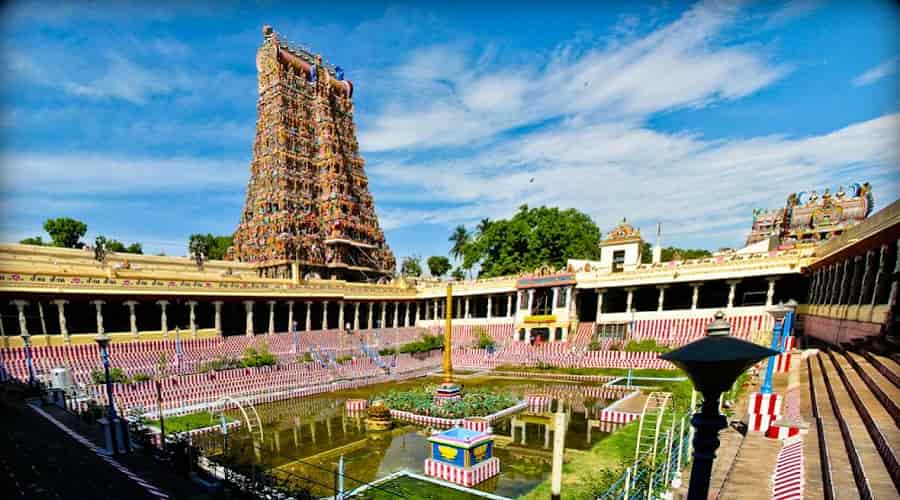
Positioned on the banks of river Vaigai, Madurai is one of the oldest cities in India, with a history dating all the way back to the Sangam period of the pre-Christian era. Madurai has a precious cultural legacy passed on from the great Tamil era more than 2500 years old. It was the center of the Tamil Academy (Sangam) of learning. Concentric rectangular streets enclose the temple, stand for the structure of the cosmos. The temple complex is situated within a high-walled enclosure, there you can find two sanctums, one for Goddess Meenakshi and another for Sundareswara, surrounded by a number of smaller shrines and illustrious pillared halls. Particularly remarkable are the 12 gopuras. Their high towers rise from solid granite bases, and are decorated with stucco figures of deities, mythical animals and monsters painted in vibrant colors. The King Kulasekara Pandya built this eminent temple and formed a lotus shaped city around the temple. On the day the city was named, Lord shiva blessed this city and its people. Divine nectar (Madhu) was showered on the city. This city was hereafter known as Madhurapuri.
Mahabalipuram Temples
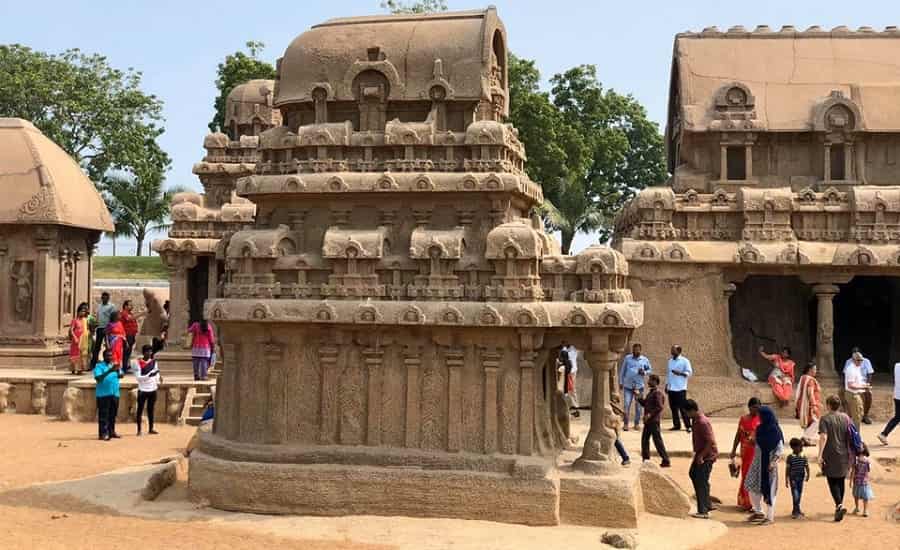
Mahabalipuram is nearly 60km south of Chennai and situated on the Coromandel Coast next to the Bay of Bengal. Once it was a well-established sea port during the 7th and 10th centuries of the Pallava dynasty. Mahabalipuram is packed with rock-cut caves and several temples. In fact, this place is often referred as an open air museum. Some of the temples were even carved out of one giant rock rather than simply constructed out of rocks. There are nine monolithic temples found in Mahabalipuram, the most focal are Five Rathas known after the famous five Pandava brothers of the Mahabharata fame. These monuments are carved out a single rock with choice of all known forms of plan and elevations. Not much prowling has occurred here over the centuries, since the wealth of the Pallavas was never displayed, so the temples are well conserved.
Srirangam Temples
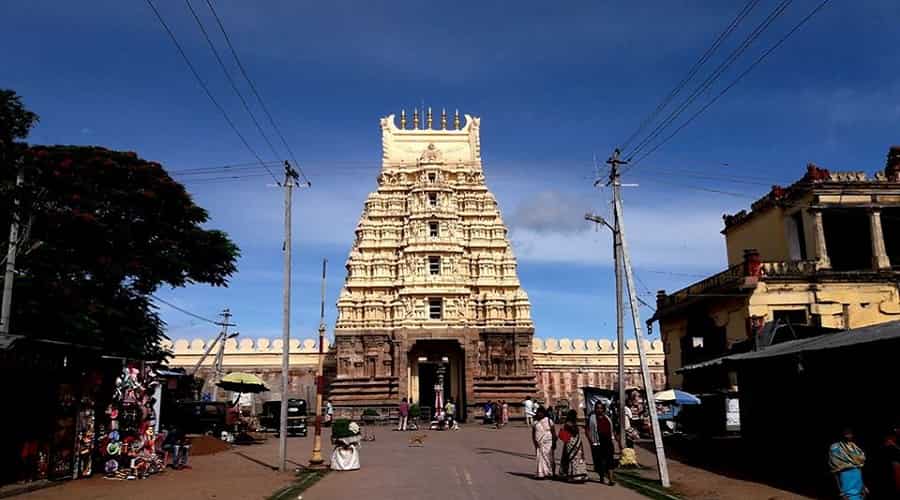
Srirangam near Trichy is actually a 600-acre island-town, surrounded by the waters of the River Cauvery on one side and its tributary, the Kollidam on the other side. It is also considered one of the Divyadesams. Srirangam is the first, foremost and the most important of the 108 main Vaishnavite temples in India. The gigantic temple complex of Lord Ranganatha, occupying 613,000 sq meters (156 acres), is the pride of Tamil Nadu. It has seven enclosures. These enclosures are constructed by thick and huge rampart walls which run around the sanctum. There are 21 glorious towers in all prakaram giving a matchless sight to any visitor. Even though the early Sangam literature makes references about this temple, the most primitive extant inscriptions date back to the 10th century. More or less all the major empires that ruled this area, like the Cholas, the Cheras, the Pandyas, and the Hoysalas have played a role to construct it as the biggest temple complex in India.
Kanchipuram Temples
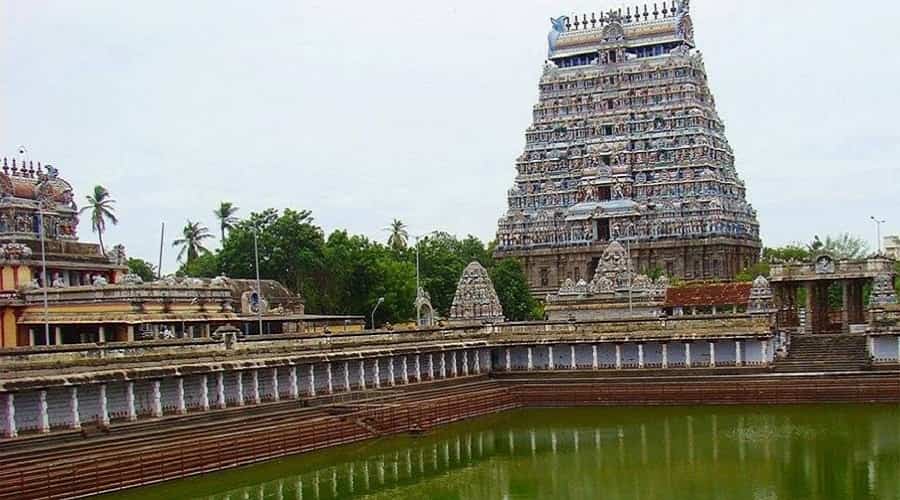
Kanchipuram is the city of thousand temples. Kanchipuram city is famous for its Temples. All the various temples in Kanchipuram belong to the Dravidian style of temple architecture. Kailasanathar Temple is dedicated to Lord Siva, it is one of the earliest temples built by Rajasimha and his son Mahendra in the 8th century A.D. There are 58 small shrines to be found around the main shrine.
Kanyakumari Temple
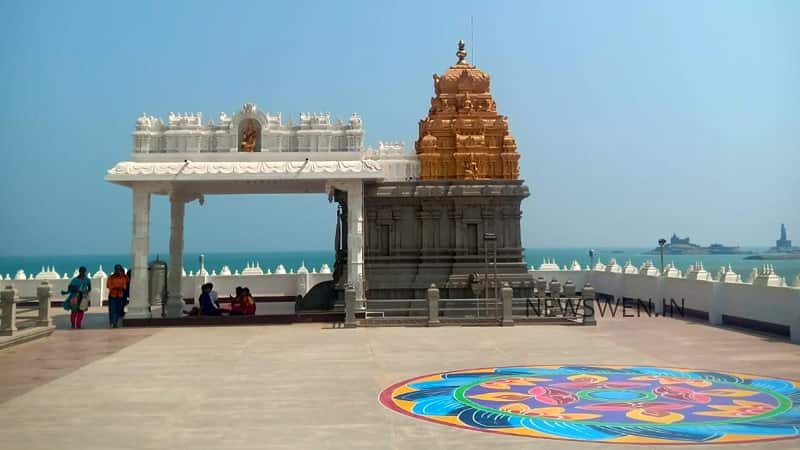
Kanyakumari is located in the southernmost tip of India and it is the convergence point of the 3 seas namely, the Indian Ocean, the Arabian Sea and the Bay of Bengal. It is dedicated to Goddess Parvati and the temple is located on its shore.
Kanyakumari is also known as the Kumari Amman Temple and is committed to Goddess Parvati in the form of Devi Kanya who is a virgin goddess. She had attempted the penance of holding the hand of Lord Shiva. The temple of the Kanyakumari is the main attraction for the tourist along with the ghats present beside the temple. It is believed that the nose ring of diamond of the deity present here is very shiny and that is even visible from the sea.
The temple has two rocks emerging out from the ocean and is situated in the direction of south eastern part from the Kumari Amman Temple. One of them is Shripada Parai, where the footprint that belongs to the Goddess Parvati is noted. It is believed that Swami Vivekanand had gone into deep meditation on this place and hence, Vivekananda rock was constructed here in the year of 1970. Apart from this construction, the dhyana mandapam which is built for the purpose of meditating is one reason of the serene environment found near the temple.
[Must Read: Top 10 Things to Do in Chennai]
